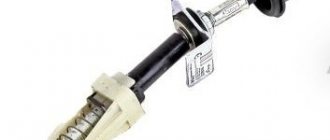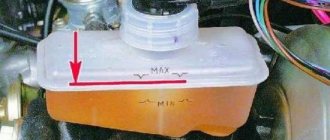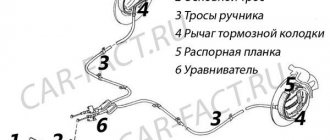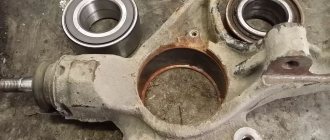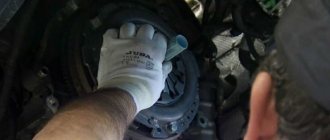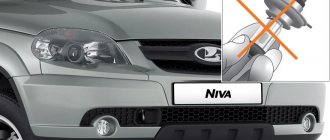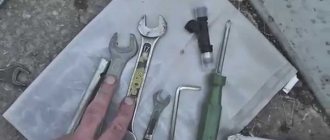What to do if the clutch slips?
If the clutch mechanism has been working for a long time and is very old, you are convinced that it is time to change it, then buy a new set of discs and other spare parts and get ready to completely replace it.
During normal, proper operation of the vehicle, clutch discs are designed to last 100 thousand km. mileage The picture shows the clutch cable sheath with adjusting nuts
Driven disk (ferodo)
The most common malfunction is wear and damage to the driven disk linings. Rubber pads are the most vulnerable link in the clutch. They are made of rubber or composite heat-resistant material and are built into the metal of the disk. When chips or cracks form on them, they cannot be replaced separately from the disk. When the linings wear out or change their original shape, the entire driven mechanism has to be changed. The passive drive must also be replaced in the following cases:
- If the disk itself is deformed;
- Damper springs broke due to overheating;
- The splines in the hub have worn out.
When oiling the friction linings with ferodo, it is enough to wash them with kerosene, lightly sand them with zero to create roughness, and they will still work.
Clutch basket
The clutch basket presses the passive disc against the flywheel. It consists of a pressure plate, a diaphragm spring and a casing. The clutch can also slip when the elements of the basket are faulty. Symptoms of failure of the basket are the same as when the driven disk fails
So, if inspection of the ferodo does not reveal obvious defects, you should pay attention to the next block of parts. It is when there is a problem with the basket that the gears stop shifting
But to make sure that it is the basket that is to blame for clutch problems, you will have to dismantle and diagnose this unit. Basket malfunctions include weakening or breakage of the diaphragm spring, breakage of the release bearing (13). The diaphragm spring wears out faster and more often. Due to constant temperature changes, its petals lose their springy properties and become fragile. With frequent overheating, blue burn spots appear on the petals. And since the cause of overheating is poor operation of the mechanism release clutch (13), it should also be diagnosed. The petals themselves are deformed and do not lie in one plane. The appearance of cracks and mechanical damage on the spring indicates the need to replace it. The basket must be completely replaced even if the curvature of the pressure plate exceeds 0.8 mm. The disc is placed on its edge, and the curvature is measured with a ruler.
Flywheel
This unit also wears out during operation of the VAZ 2114. The following signs indicate flywheel wear:
Strong vibration in the floor when you depress the clutch pedal,
Burnt smell;
- Inability of the gearbox to shift to the next gear, i.e. gear slipping.
- Sometimes you hear grinding gears when changing gears.
Inspection and diagnostics of the angles will show why the clutch on the VAZ 2114 is slipping, whether a complete replacement of all parts of the clutch system is necessary, or whether you can limit yourself to adjusting and replacing individual elements. Let us remind you that if the clutch has exhausted its service life, it is useless to patch it; it is better to change the entire system.
When adjustment is necessary
The clutch drive, as a rule, if it is not adjusted properly, is located either slightly above the brake pedal or slightly below. As a result, it becomes completely inconvenient to use, which ultimately significantly increases the risk of creating an emergency situation on the road.
The problem arises primarily due to the fact that the position of the pedal changes as the spacers installed on the driven disk wear out. The longer the vehicle is in operation, the more noticeable this defect is.
For VAZ-2115 cars, the manufacturer has established the standard travel of the clutch control pedal - a minimum of 12.5, a maximum of 13.5 centimeters. The maximum permissible deviation in this case cannot be more than 16 centimeters.
Among other things, it is necessary to carry out adjustments in a situation where the unit in question has stopped completely shutting down or is slipping. The procedure itself involves debugging by shortening or lengthening the clutch cable, as well as its sheath.
It will be useful: Tuning frets Kalina hatchback with your own hands: video instructions
Design
How to properly adjust the clutch on a Priora
The mechanical type drive on the VAZ-2114, despite the fact that it has the least simple design, is in no way inferior in reliability to its hydraulic counterpart. Its system consists of a cable adjustable in length, sealed in a special anti-corrosion sheath, and the clutch pedal itself located in the car's interior, which, through free movement, is designed to transmit the pressing force to the clutch fork.
Despite the fact that such a scheme is simple, in general it is quite reliable.
Clutch diagram
A new product in the form of a clutch cable for VAZ-2114 cars helped to avoid all the problems that all owners of classics encounter. First of all, this refers to the leakage of hydraulic fluid from the system, and as a result, loss of control over the car. It would also require work to remove air from the clutch system after repair.
At the same time, periodic checking and adjustment of the clutch pedal has remained the same.
Why is it necessary to adjust the cable travel?
This procedure is necessary so that when the pedal, and with it the clutch cable, reaches certain values, the most squat pressing of the flywheel with the basket to the driven disk is made, at the moment when its operation is necessary. At the same time, thanks to the precise adjustment of this drive, the clutch is released at the moment the clutch pedal is released.
Note! During operation of this system, when the lever is in the neutral position, or when it is turned on, no extraneous sounds or crackles should come from the gearbox housing. You can monitor the condition of the clutch, preventing such a situation from occurring, visually by positioning the clutch pedal relative to the floor of the car, using only a ruler
You can monitor the condition of the clutch, preventing such a situation from occurring, visually by positioning the clutch pedal relative to the floor of the car, using only a ruler.
Values
The optimal values should be from 125 to 140 mm, when measuring readings first with the pedal pressed and then with the pedal released. The maximum value that is allowed when measuring such indicators is 160 mm, and if they exceed these values, then this will mean severe wear of the friction linings, and therefore, after adjusting it, the clutch itself may soon need to be replaced.
We measure the result along the bottom edge of the pedal - in the photo the result is normal.
When is clutch adjustment required?
VAZs use a dry type of clutch, that is, there is a basket consisting of two parts - driving and driven
Clutch adjustment of the VAZ 2114, and other vehicles, is carried out in cases where defects associated with the operation of this mechanism appear. Such malfunctions include:
In another case, the need to adjust the clutch drive may arise due to previous incorrect adjustment. It is possible to reduce or increase the working stroke of its pedal.
The photo shows the clutch of a VAZ 2114
As a result, malfunctions occur in the operation of the drive - the clutch begins to “slip” or “drive”, gear shifting becomes difficult, jerks appear when starting from a standstill, fuel consumption increases, etc.
Which cable to choose?
How to properly adjust the clutch on a VAZ 2114
Operating a vehicle with a faulty clutch cable is not prohibited by law. But this defect makes driving the car inconvenient and uncomfortable. A part may suddenly break at the most inopportune moment. And then driving will become almost impossible. There is also a high risk of an emergency if an element breaks. Therefore, if a malfunction is detected in the operation of a part or its external damage, it is necessary to replace it within a reasonable time. You should contact a specialist for this only as a last resort, when you were unable to carry out the replacement yourself.
Analogs are also sold in auto stores and on the Internet. They are often cheaper, but the quality is in no way inferior to the original. The average cost of such spare parts is 350 – 400 rubles. They are produced by many Russian manufacturers. The products of the DAAZ brand have proven themselves well. Sometimes on the Internet you can find offers for the sale of used items. It is not worth buying such used parts. It may be dangerous. After all, it is very difficult to assess their condition from photos. An unexpected breakage of a part while driving can lead to dire consequences. And a new spare part is inexpensive. Therefore, such dubious savings are undesirable.
Clutch adjustment
How to tighten and adjust the handbrake on a Renault Logan: video and photos
Domestic VAZ-2114 cars are far from ideal, but in terms of quality they can compete with many modern economy class cars.
Due to the low price, availability of parts and simplicity of design, this vehicle is very popular among car enthusiasts.
Below we will try to consider in detail the issue of setting up the clutch system, we will study the main problems and nuances that arise during this event.
Adjusting the VAZ-2114 clutch is a fairly simple procedure, the implementation of which guarantees efficient operation and safety. In the latter case, failure of this mechanism can lead to fatal consequences.
As a rule, the main symptom requiring clutch adjustment is a change in pedal travel. This parameter is specified in the technical documentation of the transport. If you notice deviations from the established norm, you need to quickly begin to solve the problem.
The clutch system of front-wheel drive cars of the VAZ family has some differences from classic cars of this brand. The stroke of the clutch fork is controlled using a cable.
Next, we will look at how the VAZ-2114 clutch is adjusted, as well as the main signs that require this procedure.
Clutch system malfunctions
All mechanisms and components of the car have a limited service life. Unfortunately, the manufacturer does not give exact deadlines after which it is necessary to replace and adjust all parts of the clutch system.
Long-term operation without regular diagnostics can lead to certain mechanisms failing at the most inopportune moment.
The most obvious symptoms that require adjustment of the clutch system are problems with gear engagement, extraneous sounds when depressing the corresponding pedal, poor traction, partial engagement of the clutch, and so on. Most often, the situation can be corrected by adjusting the pedal.
Clutch diagnostics
Diagnostics must be carried out on all cars without exception. Regular implementation of this procedure allows you to minimize the likelihood of breakdowns of all kinds. It makes it possible to detect failures and problems at an early stage.
Thanks to this, repair work is carried out with minimal time and financial costs. Certain diagnostic procedures require special equipment. It can be found at any car service center. It is not recommended to buy them yourself due to the fairly high price of these devices.
Below are operations that you can perform independently without special technical devices.
Diagnostics of the VAZ-2114 clutch is carried out in several stages:
You also need to pay attention to the pedal travel. It should not be accompanied by any jerks or interruptions
The lowering and raising of the lever should be smooth. If the pedal jerks or sticks, you need to check the clutch adjustment.
Using a ruler, check the distance from the car floor to the outside of the pedal. The exact required value is indicated in the technical documentation of the VAZ-2114.
Press the pedal all the way, then release it and measure the distance; if it does not correspond to the stated distance, it is necessary to adjust the pedal.
How to adjust the clutch on a VAZ-2114
The essence of this procedure is to change the length of the cable sheath relative to the control unit for this function. Thanks to this action, the pedal stroke can be reduced or increased.
How to adjust?
An out-of-control drive is located several centimeters higher or lower relative to the brake. This makes the drive inconvenient to use and can cause accidents.
The drive position changes as a result of wear on the driven disk linings during prolonged driving of the vehicle. For VAZ 2115 cars, pedal travel is considered normal to be 125-135 mm. The maximum safe stroke does not exceed 160 mm. Adjustment is also necessary if the unit does not turn off completely or is slipping. Debugging is carried out by changing the length of the clutch cable and its sheath.
Tools
2 keys for 17. On the VAZ 2115, the lower end of the cable “jacket” is held on by two fasteners, which are loosened using these keys.
17 keys - the main tools for adjusting the clutch cable
Step-by-step instruction
- Initially, it is worth measuring the pedal deviation from the norm. To do this, you need to push the drive to the maximum, then release it. It is necessary to measure the stroke length - the distance from the center of the pedal pad in its lower position, when it is resting on the floor, and in its upper position. If the deviation from the normal length is significant, the pedal should be adjusted.
How to change and adjust the cable yourself?
We figured out why the pedal creaks, now let's talk about adjusting the clutch on the VAZ 2114.
When there are problems in the functioning of the system, they must be eliminated. One of the most common problems is a broken cable. Therefore, if the pedal fails, then before properly adjusting and tightening the cable, it must be changed.
Read also: Which tank will be filled first? Answer: 90 Americans
If you are experiencing problems with your pedal squeaking, check out the video that demonstrates the procedure for lubricating the device. Filmed by VikiNow.
Required Tools
To adjust the tension and replace the cable, you will need the following devices and tools:
- the cable itself;
- Litol lubricant;
- set of open-end wrenches;
- ruler;
- pliers.
How to replace it correctly?
To repair the cable, you need an assistant:
- Open the hood of the car and remove the bolts securing the battery terminals.
- You need to disconnect the connected cable from the pedal itself. Using a 17mm wrench, unscrew the nuts securing the bottom of the product. Then remove it from the retainer and remove it from the plug installed in the engine compartment.
- Further steps are carried out in the car interior. Move the carpet away from the driver's seat. There is carpet under the pedals, it needs to be removed. This will allow you to find the place where the cable is attached to the pedal; the clamp must be disconnected from it. There will be no problems, since this element is simply removed from the hook.
- After which the cable itself is removed from the seat. To do this, the device must be pushed away from you towards the engine compartment. When the product is difficult to push out, most likely its fastening has soured. Then lubricate the retainer with WD-40 and work it out a little, moving it in different directions. If you have an assistant, while you are developing the cable, he can pull it from the side of the engine compartment, this will speed up the procedure.
- After dismantling the product, a new one is installed. Before this, the bushing that secures the cable is removed from the clutch pedal. If its condition is poor, it is worn out, it is advisable to replace the bushing. The retainer itself is lubricated with Litol before installation.
Channel Sdelaj Sam! Pljus interesting! A video has been released showing the procedure for replacing a product with your own hands.
How to adjust free play?
After repairs, the cable is adjusted in height. If you do not adjust the stroke adjustment and adjust it, you will have difficulty changing gears. Before tensioning and adjusting the cable, it is recommended to test drive the machine. It will allow you to figure out how to properly tighten the pedal - raise or lower it.
Position tension diagram:
- If the car begins to move at the end of the pedal stroke, open the hood and locate the cable attachment location. There are two nuts here that can be unscrewed with a 17mm wrench. To reduce the free play of the pedal, that is, lower it, the bolt located inside the bracket is unscrewed. The outer screw must be tightened with a wrench.
- If, when starting to move, you realized that the free play should be increased, that is, raise the pedal, then the inner screw on the metal clamp should be tightened, and the outer one should be loosened. If there is rust on the free play adjustment nuts, it must be removed using WD-40. If there is no fluid, motor oil or brake fluid is used.
- If the adjustment is successful, check the free play with a ruler. If the actions are performed correctly, its length will be from 12.5 to 13.5 cm. This distance will be directly from the pedal itself in the car to the floor.
The VikiNow channel published a video showing the process of changing the cable and further adjusting its free play.
Checking work
If everything was done correctly, then you should make sure that the task was completed correctly. To do this, you need to press the pedal all the way several times, then measure the free play again. After pressing, it may go astray. If this happens, adjust the stroke again. Ideally, the clutch should engage in the middle.
How to check whether all actions were performed correctly:
- The VAZ 2114 car is installed on a flat horizontal surface.
- The handbrake lever is activated.
- The machine engine starts, the shift lever is moved to the first gear position.
- Try to start, but don't press the pedal. When all the setup steps have been completed correctly, the machine’s engine will stall. If the car starts to move, the mechanism needs to be re-adjusted. In this case, all the steps described above are performed again.
Clutch pedal adjustment
Periodic adjustment of the VAZ 21014 clutch pedal is carried out for the following reasons:
- When driving on a non-adjustable clutch pedal, subsequent repairs are possible, because exaggerated energy costs for incorrect operation of the mechanism will cause malfunctions of other components of the car.
- Due to improper functioning, the clutch pedal periodically does not function. This leads to the fact that the pressure plate of the unit is forced into “engagement” with the motor flywheel, as a result of which they are subject to accelerated wear.
- If the pedal stroke is insufficient, the vehicle slips, i.e. the required torque of the wheel pair is lost.
To carry out diagnostic work on adjusting the clutch pedal, you need to use an arithmetic ruler to measure the length of the pedal stroke to the floor. If it does not correspond to 16 cm, then adjustments are necessary.
Signs of incorrect operation of the clutch mechanism: there is no possibility of a smooth start from a standstill, movement from a standstill is accompanied by jerks and jolts, when changing gears the transmission makes increased noise, the pedal of the mechanism falls to the lower position. In practice, it turns out this way: if the vehicle began to move from the moment the pedal began to be lowered, then the free play does not correspond to the required value. When the pedal is completely released, the vehicle does not move, which means there is no free movement in the car.
Clutch pedal adjustment:
- Unscrew the nut located under the clutch pedal.
- Tighten the locknut located below until it stops.
- Next, screw in the fasteners located under the clutch pedal.
- We tighten the rubber washer to the clutch fork as far as possible.
- To increase the pedal stroke, you need to screw the fastener onto the tip. To reduce the pedal stroke, you need to unscrew this fastener. The VAZ 2109 clutch pedal is adjusted until the limit of 12-13 cm is reached.
- After completing the pedal adjustment operations, you need to: depress the pedal three times, measure the length of the pedal stroke, adjust the operation until the required stroke length is achieved.
To adjust the hydraulics you need:
- Remove the spring from the mountings of the working cylinder and the clutch fork.
- Adjust the fasteners located on the clutch cylinder rod.
- The recommended free play value is 0.5 cm.
Often, a large pedal stroke depends on the height of its location from the driver's floor, and this creates certain difficulties. To adjust the height, a series of simple plumbing operations and a wrench set to “12” are required:
We find two fasteners on the steering column shaft, one is a thrust screw that limits the height adjustment position, the second is a lock nut that changes the movement of the pedal.
- Unscrew the stop screw.
- We give it rotation until the pedal movement normalizes.
- Screw in the locknut.
If slippage is observed after adjusting the clutch, then the following operations must be performed:
- Remove the stem locknut.
- Move it until there is no free movement.
- Return the rod one full turn.
- Determine whether the clutch has free play.
- Test the operation of the transmission gears. If there is an incomprehensible noise, you need to perform the above operations again.
- Screw in the locknut.
Clutch VAZ 2115
- Phillips screwdriver or No. 8 head;
- set of open-end wrenches for 13 and 17;
- WD 40 or similar product;
- ruler/construction tape measure/other measuring instrument.
Replacement
a set of serviceable clutch parts for VAZ 2114; sets of spanner and socket wrenches; mandrel; jack.
Let's move on to replacement.
Remove the front wheels.
Disconnect the ground wire, drive and speedometer cables from the gearbox. It is not necessary to disconnect the cables, but it is worth doing for convenience.
We also disconnect the gear shift drive and the support from the gearbox side.
Use your hands to unscrew the lower casing that protects the flywheel. Inspect the condition of the flywheel. If we notice significant cracks and other defects on its surface, it means it is faulty. Remove (by hand).
Using a size 7 spanner, unscrew the bolts that secure the ball joints. As a rule, there are only 3 of them.
If we are making a complete, rather than selective, replacement, we disconnect the drive shafts from the gearbox and drain the oil. After which you can carefully remove the gearbox.
Using a size 8 spanner, unscrew the bolts securing the pressure plate to the flywheel.
Remove the pressure and driven discs. The pressure plate is also called the basket. At this stage, you need to make sure that it is working properly. Otherwise, replacement will be required. The working surface should not have cracks or large gaps.
We pry up the ends of the return spring that secures the release bearing.
Remove the clutch, bearing and return spring. We inspect each of the parts in order to understand which ones should be replaced. We twist the bearing in our hand. If you hear a crunching or noise, the bearing is bad, we are preparing a new one for replacement.
Remove the switch plug. We treat the parts with kerosene; if any of the parts are in good condition and do not need to be replaced, we carry out a selective replacement rather than a complete one.
We return (or attach a new one) the release bearing, clutch and return spring.
To center the crankshaft, insert a mandrel into its hole. Then we install the driven disk on the mandrel.
We screw it with bolts (with a spanner onto the pressure plate (basket) into the flywheel.
the pressure plate (basket) into the flywheel.
Adjustment
Initially, it is worth measuring the pedal deviation from the norm. To do this, you need to push the drive to the maximum, then release it. It is necessary to measure the stroke length - the distance from the center of the pedal pad in its lower position, when it is resting on the floor, and in its upper position. If the deviation from the normal length is significant, the pedal should be adjusted.
Deviations from the norm can be detected without measurements. To do this, you need to place the car on a flat horizontal surface, engage first gear and, smoothly releasing the drive, start moving. If the car starts moving only at the end of pressing the pedal, debugging is necessary.
In order to adjust the drive of the VAZ 2115, it is necessary to change the length of the cable jacket. To do this, you need to loosen or tighten the two nuts with which it is attached to the bracket.
Open the hood. Remove the air filter. We find the cable and nuts that secure it to the bracket. They are located on its threaded part. Unfortunately, on the VAZ 2115 these parts are located inconveniently. When manipulating the nuts, the length of the cable jacket changes. In order to reduce the stroke, loosen the nut located inside the bracket and tighten the nut outside, and vice versa, if you need to increase it.
If the threads are rusty, you can use liquid to make the threads easier to remove. If there is none, you can use engine oil or brake fluid.
After debugging, you should check changes in the operation of the node. This should be done in the same way as during the initial check for deviation from the norm. After correct adjustment, the stroke does not exceed 135 mm. If the procedure does not lead to anything and the clutch of your VAZ 2115 continues to slip, then the element has become unusable and needs to be replaced.
As a vehicle ages, all its main components and mechanisms also wear out.
For this reason, it is extremely important to periodically inspect the machine - this will allow you to identify the problem in time and fix it before it leads to a more serious breakdown.
Timely adjustment and inspection of the clutch on the VAZ-2115 will avoid failure of this unit and eliminate the need to replace it. In a car service, as you know, this procedure is not cheap, and it takes a lot of time.
In this material we will tell you in detail exactly how to correctly perform this operation and the sequence in which to perform all the necessary actions.
How to adjust the clutch on a VAZ 2115
- Blog
- Repair and service
- Box
- How to adjust the clutch?
- New items in the world of cars
- Auto market announcements
- Popular
- Engine
- Body
- Salon
- Cooling system
- Box
- Filters
- Tires and wheels
- Electrical equipment
Adjustment procedure
First, install the vehicle on a level surface. I engaged first gear, trying to initiate movement, releasing the clutch of the VAZ 2114 as smoothly as possible. Our main task is to clearly find the pedal position at which the car begins to move.
If the car only starts to react when the pedal is actually pushed to the floor, you will have to do a full tune-up. Before adjusting the clutch on a VAZ 2114, you need to open the hood and find two fastening nuts that are responsible for fixing the cable to the bracket. They can be found in the part of the cable on which the thread is applied. Setting the full stroke of the pedal mechanism is quite simple: to reduce it, loosen the nut on the inside of the bracket, and the outer one on the other side. tighten.
How to install the clutch disc correctly on a VAZ 2109
The clutch in a car serves as the connector between the engine and transmission. This unit takes on all the load that occurs when changing gears. Accordingly, the part can rightfully be considered a consumable item, because car owners regularly face the need to replace it or schedule maintenance.
It is almost impossible to influence the degree of wear of this unit. Therefore, after the clutch has exhausted its service life, it must be replaced partially or completely (in case of serious malfunctions).
When is it necessary to change the unit?
The mechanism requires servicing in the following situations:
- The clutch "drives". Motor power drops.
- The unit slips or incomplete activation occurs.
- Clicking noises are heard when changing gears.
- The clutch disengages automatically.
- Vibration is noticed when the clutch pedal is pressed.
Nuances of the work
Following all the recommendations from the automaker's manual does not guarantee that everything is done simply and quickly. Not every car owner has the opportunity to drive the car onto a pit or overpass. A lift is perfect for carrying out work, but not everyone has one either.
When you contact any service, the replacement will be made within a couple of hours, but for such a service you will need to pay a considerable amount. It may take a whole day to do the work yourself. Maybe more if you don't have experience in car repairs.
Most of the time is spent on disassembly and assembly. The operation to replace the node will take you no more than half an hour. Later in the article we will look at the process of replacing a clutch without a pit/lift.
Before starting work
Almost every car owner is interested in the question: is it possible to perform a replacement without dismantling the gearbox? You are unlikely to find a definite answer, but the procedure is quite feasible. First of all, find several large stumps up to 40 cm high, and also get a few additional bars. To prevent the car from simply falling during the work, take care to install a pair of regular wheels under the car.
Whether to remove the gearbox or not - you will have to answer this question specifically. Because if you act carelessly, the gearbox may simply fall to the ground, and lifting it from under the car will be very problematic.
Initially, disconnect the battery so that the machine's electrical system is de-energized. You can then proceed to the process shown in the following list:
- Remove the wheels and move them away from the car.
- Remove the steering ends and free the racks.
- Unscrew the ball joint mounting bolts.
- Remove the engine protection using the cable.
- The next step is to drain the oil from the box.
- Loosen the rocker nut and remove it.
- Unscrew the nuts on the two pillows.
- Place a jack or other support under the engine.
- Disable the reverse sensor.
- Disconnect the wires from the starter, unscrew the nuts and dismantle it.
- Unscrew the nuts on the flywheel guard and fork.
- In this step, remove the CV joint on the right side. The left side should not be dismantled.
- Unscrew the fixing bolts to the gearbox block.
- In the last step, unscrew the nuts that are located above the right CV joint.
Clutch replacement
After the preparatory work has been completed, you can remove the box. However, don't rush. To continue the process, take the two bolts from the upper arm. These elements have a thread suitable for our situation. Screw them in from above and you can begin to separate the units using a crowbar. This clutch replacement scheme is very labor-intensive. Remove the release bearing through the gap and unscrew the basket bolts. Compared to the instruction manual, the replacement process is slightly different. The new release bearing is installed in its place. Next, the disk is placed on the flywheel, and only then the basket is put on top.
The bolts need to be tightened approximately two turns. They should not be over-tightened.
In the next step, with extreme caution, begin to slide the input shaft onto the disc splines.
During the replacement process, pay attention to the petals of the basket. These elements have an insignificant operating life
Therefore, if necessary, they should also be replaced.
After carrying out operations to replace the clutch, reassemble the car in the reverse order. At this point we can consider that the repair is completed.
To summarize, we note that from the article you learned how to replace the clutch on a VAZ-2109 with your own hands. If you feel a lack of experience in car repairs, then the best way out of the situation is to contact a service station. In this case, you will save a lot of time, nerves and money.
Do-it-yourself clutch adjustment on a VAZ 2107
This procedure is performed similarly for all classic models VAZ 2101-07 and 21214. The essence of the procedure is to adjust the clutch or play of the clutch working cylinder rod if it takes at the very end or with minimal pressure.
- standard open-end wrenches;
- screwdriver or pliers;
- ruler;
- ticks.
Basically, the calibration process looks like this.
- The car is driven onto a viewing hole or lift.
- The battery terminals are disconnected, and the car is blocked from accidentally rolling away (relevant for a pit or overpass).
- The clutch pedal stop is located under the steering column. This element is responsible for setting the working gap between the rod pusher and the pedal. A backlash of 1-2 millimeters is considered normal; if the condition is met, no calibration is needed.
- Next, you need to check the backlash of the working cylinder. To do this, unscrew the pusher rod from the clutch fork and check the existing gap.
Tools and materials
To perform the operation you will need:
- set of wrenches;
- hydraulic fluid;
- flat screwdriver;
- container for draining waste;
- rags;
- ruler or tape measure.
Preparatory work
Before starting the procedure you should:
- Drive the car onto a flat surface, inspection hole or lift.
- Put the car on the handbrake.
- Clean the RB cover and all lines from dirt, external oxidation and bitumen stains.
- Prepare all tools for easy access to them.
Call an assistant.
Setting up the clutch of an injection VAZ 2107
Fundamentally, the repair procedure differs from the carburetor in the presence of an additional dirt protection sheet. The structure is dismantled in this way.
Using a socket head, 12 shield mounting bolts (A, B, C) are removed.
Next, you need to unscrew the rear screws using a Phillips screwdriver or wrench No. 8.
- Reverse installation is carried out in mirror order.
- Otherwise, the sequence of actions does not differ from the standard procedure.
Adjusting the clutch of a carburetor VAZ 2107
Step-by-step instructions for adjusting a carburetor model look like this.
- The car is jacked up or driven into an inspection hole.
- The nominal free play position of the clutch pedal is set.
- Adjusting the release bearing play.
- Reverse fixation of the structure.
- Checking completed work.
Adjusting the clutch pedal free play
To set the required clutch pedal travel, the following procedure is performed.
Inside the car, you need to find the clutch piston pusher (located under the corresponding pedal).
- Check the working gap on the element itself; in normal condition, the gap is 0.5-2 mm. The most convenient way is to put a ruler and use it to measure the pedal stroke before the mechanism operates. If the thresholds are not met, calibration is required.
- Use a size 10 wrench to loosen the piston rod lock nut.
- Next, using the horn, turn the travel limiter nut by 13 (clockwise, decrease, counterclockwise, increase).
- When it reaches the required range, the structure is tightened in the reverse order.
You can watch the video on how to correctly set the clutch free play:
Clutch fork adjustment
Next, you need to check the condition of the working cylinder, the sequence of actions is as follows.
- You need to get under the car.
- Remove the protective covers (relevant for the injector).
Find the cylinder itself (located on the block basket).
Use pliers or pliers to disconnect the spring to release the rod from the load.
- Place a ruler along the stroke of the piston rod.
- Press the clutch fork all the way and mark its position on the measuring scale.
- Release the part and measure its movement.
- In normal condition, the play should be 2-4 mm. In its absence, the load on the release bearing increases, which leads to destruction of the unit.
- Use wrench No. 13 and 17 to loosen the rod locknut (a, b).
- Next, the rod is fixed in one position. It is convenient to clamp the pin with pliers or special pliers.
- The fixing nut is unscrewed 3-4 turns and the required backlash is adjusted.
The structure is assembled in reverse order.
You can watch the detailed setup procedure in the video:
Important points
When replacing the clutch, it is necessary to pay close attention not only to the condition of the discs, but also to the condition of the release bearing, which was mentioned above. After removing it, you need to turn it several times by hand.
If rotation is difficult or a creaking or crackling sound is heard during scrolling, then the bearing needs to be replaced. If this is not done, all the work on replacing the clutch discs will be useless, since they will again become unusable. The gearbox shaft and adjacent parts should be cleaned of dirt very carefully; it is best to wash everything with kerosene and wipe dry with a clean rag. The above is a method for replacing the clutch with complete removal of the gearbox. But sometimes car enthusiasts do without removal. To do this, the bolts that secure the box to the engine are carefully unscrewed (one at a time). In their place, studs are installed, which are slightly thinner and at least three times longer than the mounting bolts. These pins serve as guides along which the box can be moved slightly to the side. This creates a gap between the engine and the gearbox, through which the clutch discs are removed. This method is less labor-intensive, but it has its drawbacks: it will be impossible to get to the release bearing and it will not be possible to thoroughly clean the gearbox shaft from dirt.
As you can see from this article, replacing a clutch is a very labor-intensive operation. Therefore, it is necessary to follow the proposed instructions exactly. You should also not forget about safety precautions, especially when it comes to removing the gearbox. This is a very heavy unit and you should be extremely careful when handling it.
This is interesting: Robot gearbox
Copywriter with five years of experience.
Clutch adjustment on different brands of cars
For different cars, the distance for the combined pedal stroke may be different and this point must be clarified using the operating instructions. Let's look at the step-by-step adjustment procedure for different models.
VAZ-2108, 2109, 2199
The clutch adjustment procedure is as follows.
- Measure the distance between the bottom edge of the pedal and the floor with the pedal fully depressed. The optimal distance for these models is 18 - 20 cm.
- Press the pedal all the way with your hand and measure the distance from the floor to the bottom edge. The optimal value is 6 - 7 cm.
- Subtract the result of the second measurement from the first, in the end you should get 13 - 14 cm.
- Loosening or tightening the clutch is advisable if the value obtained by subtraction does not correspond to the norm.
- Hold the adjusting nut with one wrench and loosen the locknut with a second. Rotate the adjusting nut clockwise to increase pedal travel. The latter should move down.
- Take control measurements and tighten the locknut if you have achieved the required distance.
How to find out that the VAZ 2109 electrical circuit is faulty? Read about this in our author’s detailed and informative material.
"Lada Kalina"
The adjustment occurs as follows:
- Open the hood and unscrew the air filter housing bolts to remove it.
- Disconnect the mass air flow sensor and unscrew the clamp.
- Remove the cable as far as possible, holding it by the threaded end. Be prepared to overcome the resistance that the spring attached to the clutch pedal will provide.
- Use a caliper to measure the distance between the fork arm and the plastic leader. The resulting measurements should correspond to 2.7 cm.
- Use an open-end wrench to loosen or tighten the nut if you get a different result.
- Take repeated measurements by pressing the appropriate pedal.
- Reinstall the air filter.
VAZ-2107
Adjustment in this case requires the use of an overpass or pit. As a last resort, you can install the vehicle on supports using a jack:
- After adjusting the free play, you need to achieve a distance of 0.4-2 mm between the top position of the pedal and the stop. To adjust, if necessary, use a 10mm wrench and lightly unscrew the nut locking the limiter using rotational movements.
- The need to remove the protective shield arises if the engine system involves fuel injection.
- Clean the tappet threads of any dirt before applying the lubricant mixture.
- Check the stroke of the pusher as it affects the stroke of the release bearing. Push the fork back to the very end and measure the distance of the pusher stroke (4 - 5 mm). It is better to disconnect the spring from the lever in advance, otherwise you will have to apply force.
- Use a 17" wrench to adjust the pusher stroke. At the same time, hold the adjusting nut from turning. To loosen the locknut, use a 13mm wrench.
- Use the “8” key to fix the pusher and set the required distance to 4 - 5 mm using the “17” key.
- Lock the locknut and check the pedal travel. The distance between the moment of shutdown and its upper position should be 3 cm.
"Lada Priora"
In the case of the Lada Priora, you can use two methods to measure the position of the cable. In the first case, the reference point should be the clutch pedal travel (123 - 125 mm). In the second case, you can measure the length of the cable that exits the casing. 2.7 cm should be in the released state. In the vast majority of cases, drivers prefer the first method because it is more reliable.
VAZ-2114, 2115
For these models, the clutch adjustment is as follows:
- tighten the handbrake and remove the battery for maximum safety;
- locate the clutch cable in the engine compartment;
- loosen the cable end fixing nuts using two wrenches;
- achieve a distance of 125 - 135 mm by loosening or tightening the nuts;
- take the driver's seat and press the clutch pedal all the way at least three times;
- re-measure and adjust the clutch again if necessary.
Step-by-step procedure for tensioning the clutch cable on a VAZ-2114
In order to change the length of the clutch cable, we only need a wrench.
1. First of all, open the hood and look for the nuts on the gearbox housing located at the very end of the adjustment unit. Two 17mm bolts.
The clutch cable is marked with a red marker.
2. Next, loosen the locking nut, and then change the position of the adjusting nut, tightening or unscrewing it to the required length.
The nuts will unscrew easily with any pressure.
3. When the nut is screwed on, the clutch pedal will rise, increasing the length of its distance, and if it is unscrewed, the distance to the floor will decrease, pressing the pedal closer to the floor.
The arrow marks the nut for fixing.
There is no doubt that such work is much easier to carry out in the company of an assistant.
4. Upon completion of all adjustment work, the locking nut is tightened as close to the adjusting nut as possible.
When carrying out such procedures, make sure that the clutch cable itself is intact, that there is no damage or scuffing on its body and shell, and that it moves freely inside the elements supporting it. If something like this is discovered, then it is best to replace the cable with a new one, since the wear of the supported one will only increase, and it is impossible to talk about the reliability of the work performed.
Checking work
After you have completed this work, you need to check the correctness of the work performed.
- First, measure the travel of the clutch pedal.
- With the engine turned off, depress the clutch pedal several times and return it to its place.
- Next, we take a new measurement and clarify the received readings.
- If they have not changed compared to the first measurements, then the work has been completed, correctly, and the first stage of verification can be considered completed.
- And if they differ from the first indicators, it means that the locking nut was not tightened tightly, and the adjustment process must be carried out again.
There is one rule among car enthusiasts! A properly adjusted clutch should begin to engage approximately halfway through the pedal stroke.
The following test can definitively indicate the serviceability and correctly adjusted clutch:
- The car must be placed on a flat surface, the handbrake must be turned on, and the engine must be running.
- Next, we turn on the gear and try to start moving.
- If at this moment, when the clutch pedal is not pressed, the car stalls, this means that the adjustment was made correctly.
- And if this does not happen, the car is running in gear with the clutch pedal not pressed, then this will indicate clutch slipping, which will need adjustment.
Pedal travel adjustment
Now a little more detail:
- 1. If the vehicle begins to move towards the end of the pedal stroke, a small adjustment will be required. Under the hood of the VAZ 2114 there are the already familiar two nuts securing the cable holder. To reduce the pedal stroke, you need to unscrew the inner screw and tighten the outer one a little. To increase the stroke, you will have to do the opposite with the screws, that is, tighten the inner one and loosen the outer one. Before tightening the locknuts, it is advisable to treat the threaded connection with a rust converter;
- 2. After all the settings, you need to check the operation of the clutch. As a result of correctly performed work, the pedal travel should be from 125 to 135 millimeters. We measure with a ruler. This is exactly the gap that should be from the floor to the pedal on a VAZ 2114.
If after replacement there are no changes in the operation of the mechanism, then a complete repair of the mechanism will be required. This procedure is quite labor-intensive, requires dismantling the gearbox, and an inexperienced owner would be best advised to seek the help of a car service center.
Do-it-yourself tightening of the clutch cable on a VAZ-2114: adjusting the mechanism
The clutch design itself on the VAZ-2114 (Samara-2) car has been changed and differs from what was installed on the “classic” models of the VAZ family. The main changes affected the system of adjustment, control, and movement of the clutch fork. And, if previously they were hydraulic, now its movement is driven by the clutch cable.
